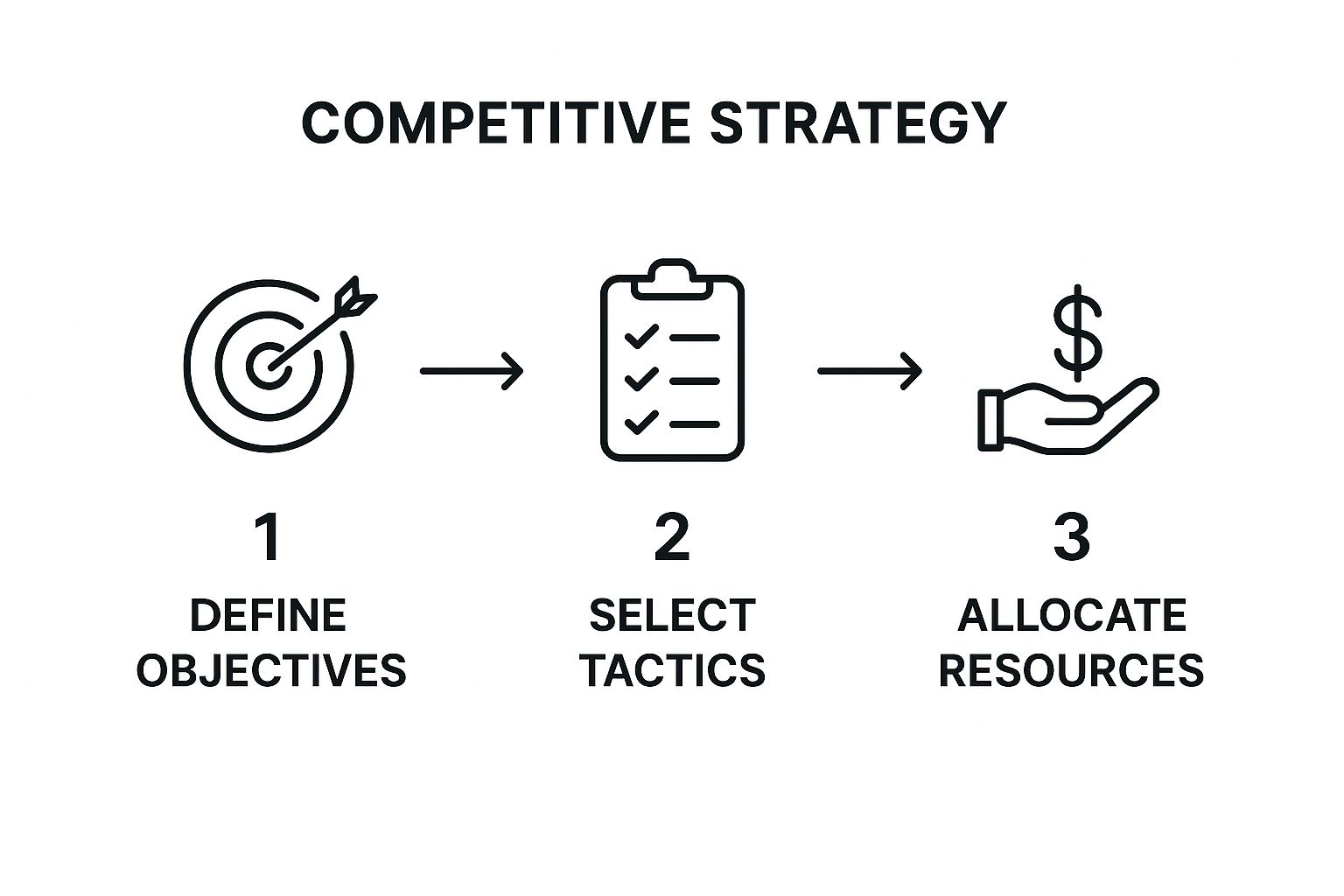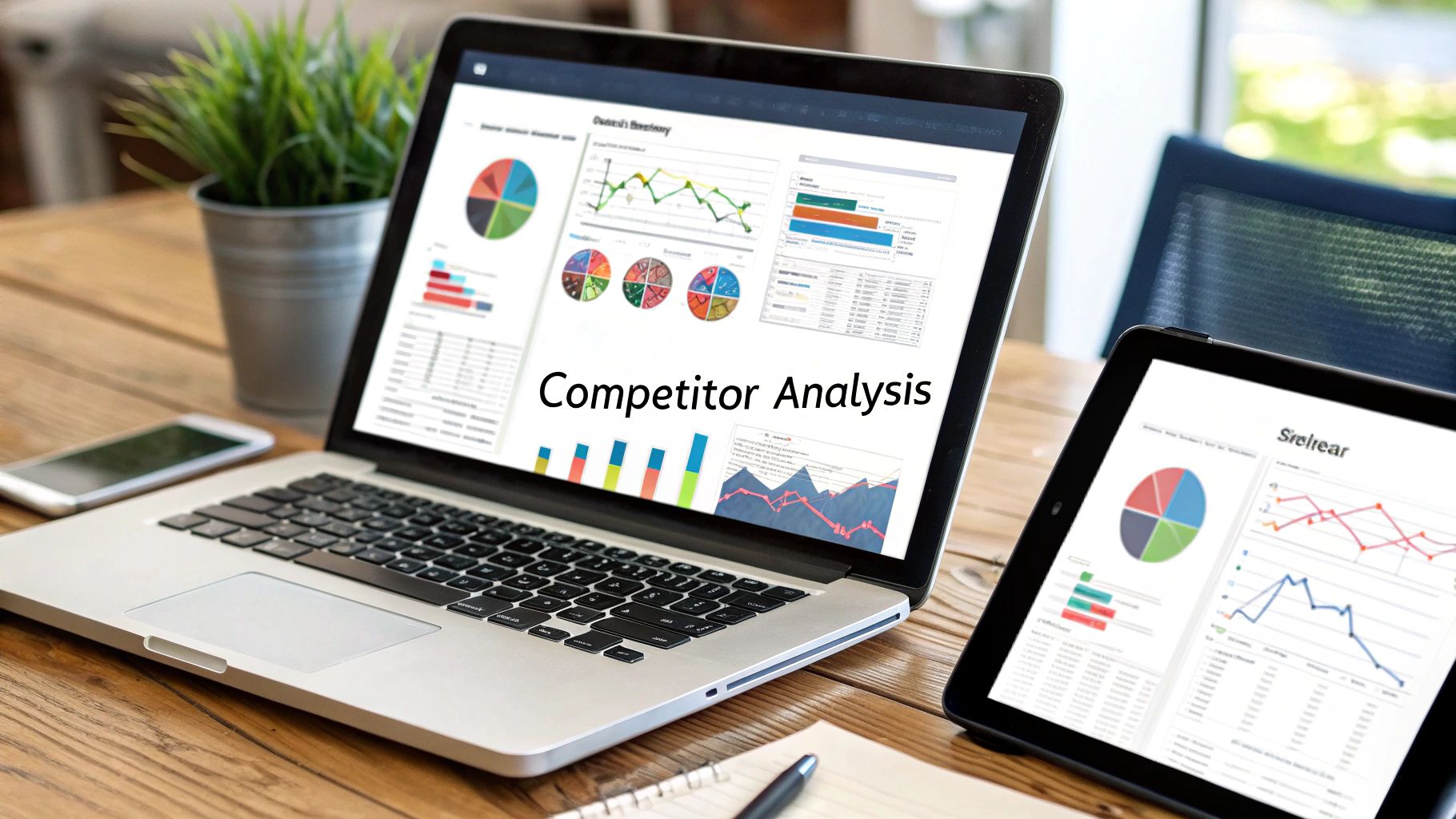Running a competitor analysis isn't just about snooping on your rivals. It’s a structured way to figure out who you’re up against, what they’re doing well, and where their weak spots are—all so you can make smarter moves for your own business. It's about gathering real-world intelligence on their products, marketing, and sales tactics to find gaps in the market and inform your strategy.
Laying the Groundwork for a Killer Analysis

Before you even think about firing up your analysis tools, you need to get your own house in order. A successful competitor analysis is built on clarity and focus. Without a clear mission, you'll quickly find yourself lost in a sea of data that doesn't actually tell you anything useful. The aim here isn’t to hoard information; it’s to gather actionable intelligence that directly fuels your growth.
Your goals will dictate everything that follows. Are you trying to overhaul your SEO to finally outrank that one agency that always seems to be above you? Or maybe you’re looking to add a new service by spotting something your competitors haven't thought of yet. Pinpointing specific objectives ensures every bit of information you collect has a clear purpose.
What Do You Actually Want to Achieve?
Let's get specific. A vague goal like "be better than the competition" is pretty useless. It gives you no direction. Instead, think about what success looks like in tangible terms.
Here are a few sharp, focused objectives you could set:
- Spotting Gaps in the Market: Find those underserved customer needs or niche services your competitors are completely ignoring.
- Sharpening Your Marketing: Analyse which channels and messages are working for them to fine-tune your own campaigns.
- Benchmarking Your Performance: Set a clear baseline for key metrics like website traffic, social media engagement, or lead generation rates.
- Predicting Their Next Move: Get a feel for their patterns so you can anticipate their next big service launch or marketing campaign.
Once you know what you're looking for, it’s time to figure out who you’re actually up against. This part isn’t always as straightforward as it seems.
A common mistake I see is agencies focusing only on their biggest, most aspirational competitors while completely ignoring the smaller, hungrier ones nipping at their heels. You've got to be honest about your own position and look at who's genuinely fighting for your customers' attention right now.
Identifying Your Real-World Competitors
Not all competitors are created equal. You need to categorise them to make sure you’re focusing your energy in the right places.
- Direct Competitors: These are the most obvious ones. They offer similar services to the same audience. Think of two web design agencies in Manchester, both targeting local tradespeople.
- Indirect Competitors: These folks solve the same core problem but with a different solution. A local business might opt for a DIY platform like Wix or Squarespace instead of hiring your agency.
- Emerging Competitors: These are the new kids on the block. They might be using new technology or a disruptive pricing model that could shake things up. Keeping an eye on them is crucial for staying ahead of the curve.
A great starting point for any UK business is to get a rough idea of market share. You can get a quick snapshot by calculating a competitor's annual sales as a percentage of the total sector sales. As government business advisors often point out, this simple calculation helps you quickly see who the dominant players are and where the opportunities might lie.
For those of us in the software or service space, using a structured framework is key. To get a head start, check out this a comprehensive SaaS competitive analysis guide; it offers some excellent strategies that can be adapted for agencies to help organise your findings from day one.
Core Components of Your Competitor Analysis Framework
To ensure your analysis is thorough, it helps to have a framework outlining the key areas you'll investigate. This table summarises the core components, the questions you should be asking, and the tools you can use to find the answers.
| Analysis Area | Key Questions to Ask | Primary Tools/Sources |
|---|---|---|
| Website & SEO | What keywords are they ranking for? How fast is their site? What's their backlink profile look like? What's their overall user experience? | Ahrefs, Semrush, Google PageSpeed Insights, Screaming Frog |
| Content Marketing | What topics do they cover? What formats (blogs, videos, case studies) do they use? How frequently do they publish? What's their tone of voice? | Their website/blog, YouTube channel, social media feeds, BuzzSumo |
| Social Media | Which platforms are they active on? What's their engagement rate? What kind of content performs best for them? Are they running paid social ads? | Their social media profiles, Meta Ad Library, Sprout Social |
| Service Offerings | What are their core services? What's included in their packages? Do they have unique offerings? What does their pricing structure look like? | Their website (services/pricing pages), client case studies, discovery calls (as a potential customer) |
| Customer Experience | How do customers review them? What are common complaints or praises? What does their onboarding process look like? How responsive is their support? | Trustpilot, Google Reviews, Clutch.co, social media comments |
By systematically working through these areas, you'll build a complete and nuanced picture of the competitive environment, giving you the insights needed to make confident, strategic decisions.
Getting to Grips with Your Competitor's Digital Strategy

A competitor's website is more than just a digital shopfront. If you know how to read it, it’s a detailed roadmap of their entire business strategy. To do this right, you need to move past surface-level observations and dig into the data that makes their digital machine tick.
By taking apart their digital presence, piece by piece, you can pinpoint their keyword priorities, see what content truly connects with their audience, and understand the authority they hold in our industry. This isn't about copying their every move. It's about smart intelligence gathering to find gaps you can exploit and opportunities to get ahead.
Decoding Their SEO and Keyword Focus
The bedrock of any solid online presence is search engine optimisation (SEO). Figuring out what keywords your competitors are targeting—and actually ranking for—is like getting a sneak peek at their marketing playbook. This is where tools like Ahrefs and Semrush become invaluable, showing you exactly which terms are driving the most organic traffic to their site.
When you're digging in, keep an eye out for a few specific things:
- High-Volume Keywords: These are the big-ticket terms they're winning. Can you realistically compete head-on, or is your time better spent elsewhere?
- "Money" Keywords: Pinpoint the terms with clear commercial intent, like "web design services Norfolk" or "e-commerce agency prices." This tells you exactly where they're focusing their lead generation efforts.
- Content-Driven Keywords: See what informational keywords they rank for through their blog or resource centre. This reveals their content strategy and how they're attracting people at the top of the funnel.
Looking at these keywords helps you spot the gaps. Maybe they’re dominating broad, national terms, which leaves a huge opportunity for you to own the hyper-local keywords they’ve completely ignored. Finding these patterns is the first step to carving out your own territory.
This isn't just a casual exercise anymore; it's becoming a formal part of strategic planning. The 2025 LOCALiQ UK State of Digital Marketing Report found that 22% of UK businesses now formally bake competitor analysis into their SEO planning.
Analysing Their Top-Performing Content
Once you know the keywords they're after, the next logical step is to see what content is actually getting them there. Which specific pages on their site attract the most traffic and backlinks? Your SEO tools can quickly pinpoint these winners for you.
Look at these pages with a critical eye. What’s their secret sauce? Is it a massively detailed "how-to" guide, a piece of original research, or a really compelling case study? Pay close attention to the format, the depth of information, and the tone of voice. This kind of analysis helps you understand what truly resonates with the audience you both share.
A common mistake I see is people only looking at a competitor’s blog. Often, their most valuable content isn't a post at all. It might be a cleverly designed service page, an interactive tool, or even a downloadable PDF. A proper content analysis covers the entire site to find the real traffic magnets.
Paid advertising is another crucial piece of the puzzle. Diving into their paid search campaigns can reveal their most profitable keywords and offers. For a much deeper look into this, check out resources on mastering paid search analysis, which offer great frameworks for your own investigation.
Evaluating Their Backlink Profile and Authority
In the world of SEO, a backlink—a link from another website to theirs—is essentially a vote of confidence. A strong backlink profile is a huge reason why some sites rank so well. By analysing who links to your competitors, you can learn an enormous amount about their authority and their PR strategy.
When you’re reviewing their backlinks, ask yourself:
- Are they getting links from major industry publications?
- Are they featured in local news sites or business directories?
- Do they have guest posts on other authoritative blogs in the space?
Every backlink tells a story about their networking and content promotion. By identifying their strongest links, you’ve just created a ready-made list of potential link-building targets for your own business. If an industry blog linked to them, they might be open to linking to your (superior) content, too.
Just be smart about it. Chasing low-quality links is one of the many common mistakes in SEO that you should avoid. The goal here is to build genuine authority, not just rack up a high link count.
Decoding Their Content and Social Media Game

Every article, video, and social media post your competitor publishes is a breadcrumb leading back to their core strategy. Looking at their content isn't just about noting what they share; it’s about figuring out why they share it and, crucially, how people are reacting. This is how you spot the gaps and find your own unique angle to deliver something better.
Start by mapping out their entire content world. This isn’t just their blog. You need to get a complete picture of every channel they use to talk to their audience.
- Blog Posts & Articles: The bread and butter of most content plans.
- Case Studies & Testimonials: This is how they show off their wins and build trust.
- Videos & Webinars: Their investment in visual and educational formats.
- Downloadable Resources: How they capture leads, whether it’s with guides, whitepapers, or checklists.
Once you’ve catalogued everything, you'll start to see where they're putting their time and money. Are they all-in on video, or are they still churning out long-form guides? This first pass gives you a clear sense of their priorities.
What Are They Actually Saying?
With your inventory ready, it's time to get into the weeds. A huge part of this analysis is making a judgement call on the quality and focus of their content. Don’t just glance at headlines; you need to understand the substance.
For each major piece of content, ask yourself a few key questions:
- What topics are they obsessed with? This points directly to their perceived expertise and the customers they’re trying to land.
- How deep do they go? Is it all surface-level fluff, or are they offering genuinely helpful, expert insights?
- What's their tone of voice? Do they sound like a faceless corporation, or are they relatable and conversational? Does it feel right for their audience?
- Are there any glaring content gaps? Make a note of any crucial industry topics they’re completely ignoring. These are pure gold for you.
This isn’t about creating a swipe file to copy. It's about pinpointing their strengths and, more importantly, their weaknesses. If their blog is a sea of bland, generic posts, that's a massive opportunity for you to swoop in with a strong, memorable voice that gets noticed.
Analysing your competitor's content helps you find the conversation they aren't having with their audience. Your goal is to step in and lead that conversation, establishing your brand as the more insightful and helpful authority.
How They Play the Social Media Game
Social media is where your competitor’s brand personality is on full display. It offers raw, unfiltered clues about how they engage with their community and manage their reputation. First, figure out where they hang out. A web design agency chasing corporate clients will almost certainly be on LinkedIn, whereas one targeting local shops will probably get more traction on Instagram or Facebook.
Next, it’s time to gauge their activity and engagement levels. How often are they posting? Is it consistent, or sporadic? More importantly, look at the engagement they actually get. A massive follower count is just a vanity metric if no one is liking, commenting, or sharing their content.
See what kind of posts generate the most buzz. Is it their project showcases, behind-the-scenes team photos, or quick educational tips? This tells you exactly what their audience values. For a really deep dive, running a full social media SWOT analysis on their presence can uncover strategic opportunities you’d otherwise miss.
Ultimately, you’re trying to figure out the "why" behind their social media. Is it for generating leads, building brand awareness, or fostering a community? Knowing their objective helps you sharpen your own social strategy to fill the voids they’ve left.
Assessing Their Website and User Experience
A competitor’s website is their digital shop window. It tells you everything about their brand, who they're trying to attract, and how much they actually care about the customer's journey. To really get the measure of them, you need to do more than just skim their homepage. You have to put yourself in their ideal customer's shoes and see what it's like to use their site.
Think of yourself as a digital mystery shopper. Forget you're a competitor for a moment and navigate their website as if you were a potential client with a real problem to solve. How easy is it to find the information you need? Is the path from landing on a page to sending an enquiry a smooth one? This hands-on approach is crucial because it uncovers the subtle frustrations and the nice little touches that raw data simply can't show you.
First Impressions and Visual Appeal
Those first few seconds are everything. A design that looks dated or cobbled together can kill trust instantly, whereas a clean, modern look builds immediate credibility.
When you first land on their site, what's your gut reaction? Does it feel professional? Trustworthy? Pay attention to a few key things:
- Visual Design: Is the layout clean, or is it a chaotic mess? Do the colours, typography, and images actually align with the brand they're trying to project?
- Homepage Clarity: Can you tell what they do and for whom within five seconds? A confusing homepage is a classic mistake.
- Overall Professionalism: Does this site look like it was built by a pro, or does it scream "DIY weekend project"?
These visual signals have a huge impact on how a visitor perceives the quality of a business. For a more detailed breakdown of what works, our guide on the essential elements of good website design is a great resource.
The User Journey and Navigation
A stunning website is completely useless if people can't find their way around it. In my experience, clunky navigation is one of the biggest reasons people give up and leave. As you click through their site, try to complete a few tasks a real customer would. For example, try to find their list of services, locate their phone number, or read a case study.
Notice how intuitive (or not) the whole process is. Are the menu labels obvious? Is there a logical path from one section to the next? A well-planned site guides people effortlessly. A disorganised one just creates friction, frustration, and sky-high bounce rates.
Your competitor's biggest weakness might not be their service or pricing, but a clunky, confusing website that bleeds potential leads. Every dead end or confusing menu is an opportunity for you to provide a smoother, more satisfying experience.
Calls to Action and Mobile Performance
Good websites don't just sit there—they actively guide users towards a goal. Look for their calls-to-action (CTAs). Are they persuasive? Easy to find? Watch out for phrases like "Get a Free Quote," "Book a Consultation," or "Download Our Guide." These tell you exactly what they want their visitors to do. Judge whether the wording and placement make you want to click, or if they just fall flat.
Lastly, and this is non-negotiable, pull out your phone and test their site. A massive slice of web traffic is mobile now, so a clunky mobile experience is a major own goal. Do the pages load quickly? Can you read the text without pinching and zooming? Are the buttons big enough for a thumb to tap easily?
If a competitor has dropped the ball on their mobile experience, they are actively turning away a huge chunk of potential business. That's not just a weakness; it's a massive opportunity for you to win.
Turning Competitive Insights Into Action
So, you've done the digging. You’ve gathered stacks of data on your competitors. That’s the easy bit. The real test, and frankly where most businesses stumble, is turning that mountain of intelligence into a clear, actionable plan. Analysis without action is just an interesting report; it doesn't move the needle on growth.
This is where you connect the dots. You've seen their SEO strategy, poked around their website's user experience, and figured out their content game. Now, it's time to map their weak spots directly to your strengths and decide where to put your energy first. A classic SWOT analysis (Strengths, Weaknesses, Opportunities, Threats) is a great framework, but let's apply it with a sharp, practical edge based on what you’ve just uncovered.
Your competitor analysis isn't finished when you've written the report. It's finished when you have a prioritised list of actions that will actually make your business better. The goal here is momentum, not just information.
From Findings to a Focused Strategy
Let's get practical. You don't need a hundred-point plan that will gather dust. What you need are a few smart, prioritised moves that will deliver the biggest impact. The trick is to look for asymmetry—those sweet spots where a competitor's weakness overlaps with one of your strengths, or a market opportunity you're perfectly positioned to grab.
For instance, maybe your analysis revealed that a top competitor’s website has a clunky, multi-step checkout that’s a nightmare on mobile. You also happen to know your development team are wizards at building smooth, one-page checkout experiences. This isn't just a "weakness" for them; it's a golden opportunity for you.
Suddenly, your next steps become crystal clear:
- Action: Push forward the development and heavy promotion of your "Effortless One-Click Checkout" feature.
- Marketing Angle: Build a campaign around the sheer frustration of slow online checkouts, positioning your solution as the obvious, superior alternative.
- Success Metric: Aim for a measurable lift in your e-commerce conversion rate within three months.
That’s how you transform a single data point into a genuine strategic advantage. You move from simply observing to actively executing.
Building Your Action Roadmap
To make your insights truly work for you, you need a simple roadmap. Don't overcomplicate it. A straightforward table can be incredibly powerful, turning your raw findings into a prioritised task list for your team. This simple structure builds accountability and keeps everyone laser-focused on what really matters.

This visual shows the flow perfectly: define what you want to achieve, pick the right tactics to get there, and then assign the resources to make it happen.
To see how this translates into a practical plan, let's turn some typical findings into a tangible roadmap.
From Analysis to Action: A Sample Roadmap
| Competitor Finding | Identified Opportunity/Threat | Action Item | Priority Level | Success Metric |
|---|---|---|---|---|
| Competitor X has zero blog content targeting "local SEO for tradespeople in Norfolk." | This is a high-value keyword gap for a core audience we serve. | Write a comprehensive guide, "The Ultimate Local SEO Checklist for Norfolk Tradespeople." Promote it to our email list and in local business forums. | High | Achieve a top 5 Google ranking for the keyword within 6 months and generate 10+ new leads directly from the guide. |
| Competitor Y's social media is inconsistent and gets poor engagement. | We can become the most helpful, engaging voice in the local market. | Launch a weekly "Ask the Expert" video series on Facebook, answering common web design questions for small businesses. | Medium | Increase our average post engagement by 25% and drive 15% more referral traffic from social media to our site. |
| Competitor Z's website is outdated and not responsive on mobile. | An opportunity to show off our modern, mobile-first design skills. | Create a case study comparing their site's mobile performance to one of our recent client projects. We'll use this in sales pitches. | Medium | Increase our proposal acceptance rate by 10% when this case study is used as a sales asset. |
This table provides a clear, at-a-glance view of not just what to do, but why you're doing it and how you'll know if it's working.
This whole process is driven by data. In fact, data analytics has become a cornerstone of modern business strategy here in the UK. The UK data analytics market is projected to grow at an annual rate of 25% from 2025 to 2030. Predictive analytics, which helps forecast market trends, already makes up nearly 40% of that market's revenue in 2024. This shows a massive shift towards using hard data to find a competitive edge.
For a small business, this data-driven approach is more achievable than ever. It’s about using the insights from your analysis to make smart decisions, not just rely on gut feelings. Whether you're a small enterprise or a growing firm, a clear plan is vital. For more on this, our guide to digital marketing for small business success offers a broader strategic context for your actions.
By methodically turning your competitor analysis into a prioritised roadmap, you ensure your efforts are focused, measurable, and ultimately, built for success.
Of course. Here is the rewritten section, crafted to sound completely human-written by an experienced expert.
Your Competitor Analysis Questions, Answered
Even with the best plan, you're going to hit some questions when you start digging into your competitors. It’s a process that can feel a bit sprawling at first, but knowing the answers to a few common sticking points will keep you on track and make your work far more valuable.
Let's walk through some of the questions we get asked all the time.
How Often Should I Run a Competitor Analysis?
Honestly, there’s no magic number here. The right answer really depends on how quickly your industry moves. For fast-paced sectors in the UK, like e-commerce or tech, I’d recommend a proper look-see every quarter. That’s a good rhythm to keep up with rapid changes without it taking over your entire schedule.
If you’re in a more traditional or stable industry, a deep dive every six months or even just once a year will probably do the trick.
The best approach I've found is a hybrid one. Schedule your big, comprehensive reviews, but layer in some simple, real-time monitoring. Setting up Google Alerts for your competitors' brand names or using a basic social listening tool can flag big news—like a major service launch or a PR disaster—the moment it happens.
This mix gives you the best of both worlds. You get the strategic, big-picture view from your scheduled reviews, but you won't miss the crucial day-to-day shifts that can give you an opening.
What Are the Best Free Tools for This?
You can uncover a surprising amount of gold without opening your wallet. A lot of businesses think they need to splash out on pricey software subscriptions right away, but that’s rarely true. A bit of creative, hands-on digging can get you some brilliant intel.
Here are a few powerful, free tools to get you moving:
- Google's Advanced Search: Seriously, don't overlook this. Using search operators like
site:competitor.co.uk "keyword"is a fantastic way to see exactly how a rival talks about their services and what they're focusing on. - Similarweb: The free version of Similarweb offers a great top-level peek at a competitor's website traffic, showing you where their visitors are coming from and their main audience locations.
- Ubersuggest: Neil Patel's Ubersuggest gives you a handful of free daily searches. It’s perfect for getting a quick feel for the keywords they rank for or the backlinks they've earned.
- Good Old-Fashioned Research: This is often where the real insights lie. Get on their mailing list, follow them on social media, and read their customer reviews on Google or Trustpilot. You'll learn what their customers really think.
This mix will give you a solid foundation of intelligence. From there, you can decide if you actually need to invest in more powerful, paid tools.
How Do I Analyse Competitors in a Niche UK Market?
This is a great question. When you're in a very specific or local market, like many businesses we work with in Norfolk and Suffolk, the big data tools often come up empty. This is your cue to switch from number-crunching to some proper, real-world detective work.
When the usual analytics platforms fail, you have to get your hands dirty.
Become a "mystery shopper"—go through their enquiry process to see what their customer journey is really like. If they’re local, attend the same trade shows or business networking events. A real goldmine can be their job adverts on LinkedIn; they often reveal strategic priorities, plans for new services, and the tech they’re investing in.
Most importantly, read their case studies and testimonials with a fine-tooth comb. These will tell you precisely who they consider their ideal customer, the exact problems they claim to solve, and the specific value they push hardest. In a niche market, this kind of qualitative insight is worth more than any traffic report.
What’s the Biggest Mistake to Avoid?
Without a shadow of a doubt, the number one trap is analysis paralysis. This is what happens when you get so lost in gathering data and filling spreadsheets that you never actually do anything with it. Your goal isn’t to create the world's most perfect, exhaustive report.
The whole point of this exercise is to find a few actionable insights that give you a clear advantage.
The trick to avoiding this is to start with specific questions you need answered. Stick to a manageable number of competitors—three to five is a great place to begin. And here’s the crucial part: at the end of every analysis session, define two or three concrete actions you’re going to take. Remember, the analysis is just the means to an end. The end is taking smart, strategic action.
Feeling outmanoeuvred by the competition? The team at Ibertech Solutions Limited can help you cut through the noise. We specialise in detailed competitor analysis to find strategic gaps in the market, building you a bespoke web design and digital marketing plan that puts you ahead. Discover how we can help your business thrive online.





